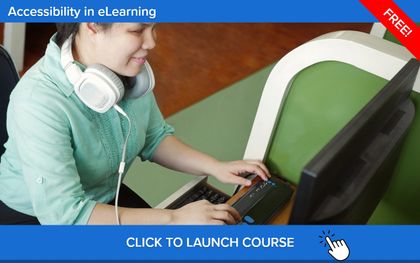How To Achieve Accessibility In eLearning: 4 Principles
Corey Bleich
🍿 5 min. read
Building in accessibility in your eLearning programs is no longer an option
An estimated one billion people across the globe are living with disabilities or impairments that make traditional eLearning impossible to access. But how do you achieve accessibility in eLearning? For Global Accessibility Awareness Day, we’re sharing four of the major design principles that can help you make your eLearning accessible to all.
At the end of this post, we also share a free fully-compliant course about accessibility, so you can introduce these principles to your L&D teams!
Why is Global Accessibility Awareness Day so important?
Thursday May 20, 2021 marks the tenth anniversary of Global Accessibility Awareness Day (GAAD). This annual event was founded in 2011 to guide the world to a better understanding of what digital access and inclusion means. For people with disabilities or impairments, this day highlights the importance of making sure that digital tools are optimized to give everyone a chance for success.
This access is desperately needed. WebAIM, an association that monitors digital access, found that over 98% of home pages had at least one Website Content Accessibility Guidelines (WCAG) 2.0 failure. The average number of failures on home pages? Nearly 61.

This means that people living with a disability or impairment run into roadblocks wherever they turn on the internet. If a home page is inaccessible, chances are good that the training materials you’re offering are also similarly challenging.
Focusing on accessibility in your training programs benefits not only employees, but also your organization. Accessibility helps you meet the needs of your entire audience with one training. This prevents the need to manage multiple versions of the same course. Accessible eLearning also decreases your legal risk.
Beyond making your life as a trainer easier and avoiding legal risk, though, the most important benefit of accessible training programs is that it provides a better user experience for everyone across your organization.
Achieving accessibility in eLearning
Some of the most common disabilities or impairments addressed by creating more accessible eLearning programs fall into the following categories.
- Visual
- Hearing
- Motor
- Cognitive
Further, employees may also have hidden disabilities that have not been recognized in the past, but require accessible learning.
When you are designing accessible eLearning courses, there are some general ground rules to follow. These start with thinking more consciously about how to design courses and set out the basic features of an accessible eLearning.
At its most basic level, each course must be perceivable, operable, understandable, and robust for all. Here’s how to get started.

Perceivable
This simple guideline means that everyone taking the course must be able to perceive the material. Effective virtual training methods and techniques include:
- Providing text alternatives (alt text) for non-text content
- Including closed captioning for audio elements (with audio description or descriptive text)
- Adapting content that allows for sensory challenges, such as including alt text for visually impaired employees
- Using distinguishable content that follows WACG 2.0 rules for background audio levels, colors, visual contrast, text size, and images
Operable
Operable eLearning means that every user can navigate your course. In practice, this may include:
- Providing narration of every text element, exactly as written, word-for-word
- Adding pause/replay content buttons
- Avoiding flashing content that could potentially trigger seizures
- Using titled pages with menus to help users navigate the content and determine where they are
- Removing any unnecessary buttons
Operable eLearning principles also limit user interactivity. This means your eLearning course does not require employees to type anything in or use drag-and-drop elements on the page.
This does not mean that employees should not be able to interact – just that interactions should be occasional and not required for an employee to get information from the course.
Understandable
We all know what it feels like to be confused by jargon, idioms, or specialized language. Accessibility best practices means that your eLearning is clear and easy to understand for every user.
This includes focusing on things like:
- Idioms and jargon: Substitute clear language and explain any jargon that is necessary (or leave it out entirely)
- Acronyms: Make sure a definition is provided, with a reference link if needed
- Reading level: In general, content should not exceed an 8th grade level, instead focus on clear and direct language whenever possible
Also make sure the delivery of the course (whether synchronous or asynchronous) moves predictably. Follow the same order of operations the whole time. Take no unexpected detours or sidebars that could confuse learners.
Along these same lines, content for the entire course should never be hidden from the user. Some employees learn best when they can revisit sections or review at their leisure. This should always be an option.
Finally, to make your eLearning more accessible, when you are quizzing participants or checking for understanding, incorrect responses should always be explained, with the correct answer provided.
Robust
An accessible eLearning course is not complete, no matter how many effective virtual training methods and techniques are employed, if the technology is not on pace with the needs of your employees.
Your content needs to be adapted and updated as better assistive technologies are developed.
Your free accessibility in eLearning course
We’ve made it easy to share these accessibility principles with anyone on your team who is involved in learning and development tasks.
Our free, fully-compliant five minute course covers the basic principles your team can use to create training that includes everyone in your organization.

We build accessible employee training
At EdgePoint, our courses are designed with the strictest levels of WCAG 2.0 compliance in mind. We also help companies like yours ensure compliance with Section 508 of the Rehabilitation Act of 1973. Find even more tips for building accessible training programs here.
We build employee training programs that actively and thoughtfully include everyone on your staff. From consulting on your accessibility needs to building entire accessible trainings from the ground up, we can help.
